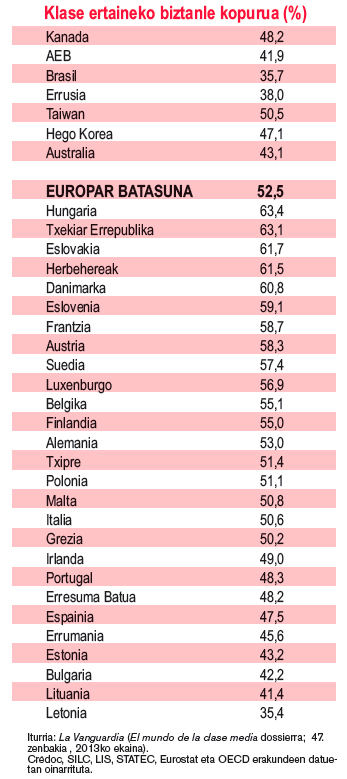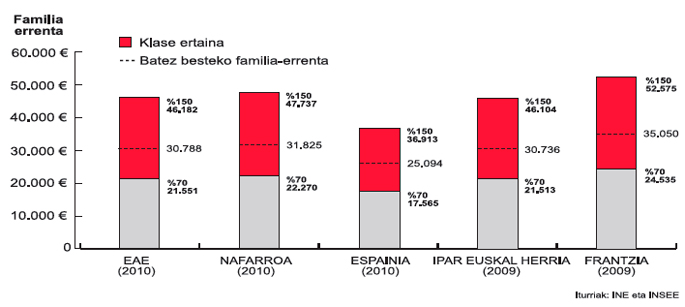
- The economic crisis in southern Europe has increased social inequalities and reduced the broad and flexible group defined as the middle class. On the contrary, in developing countries, the population has become the owner of tempting new privileges and consumption opportunities. Considered as a factor of stability, the evolution of the middle class is an inexhaustible source of controversy, as demonstrated by the discrepancies that the definition itself arouses. We have talked about the past, present and future of this group: first we have looked at history, then the socio-economic situation of Euskal Herria – with the help of the sociologist Eguzki Urteaga and the coordinator of Gaindegi Imanol Esnaola – and then different countries of the world.

Greek philosopher and scientist Aristotle said that if a political community wanted to be good, power should be in the middle class's hands, because it excludes extreme trends, guarantees stability and promotes economic growth. It was the fourth century before Christ.
Henry Ford (1863-1947), father of modern production chains, was aware that consumerism can guarantee peace when he turns his employees into clients of cars that went up and made wages. USA, Barack Obama is aware that the Davos Economic Forum talks about the fate of the middle class, and his speech on 13 February talked about measures to revitalize the middle class. “That’s our real growth machinery,” he said.
Class distribution: recent history
German philosopher Karl Marx (1818-1883) classified social classes based solely on economic terms. Two stood out above all: the capitalist bourgeoisie and the proletarians of the workers. The bourgeoisie owns the means of production and the proletariat of the work. As one exploits the other, the class conflict is permanent.
Economist and philosopher Max Weber (1864-1920) distinguished three dimensions: class (economic power, income), status (social prestige, privileges) and political power. The union of the three will determine the socio-economic position of the individual as it has been called afterwards. For example, a union leader may not have large incomes, but will have a higher position on the power scale than another person with similar incomes. Currently, it is based on this scheme and is added other elements that have been changing over time, such as the type of work, training and educational level.
Between 1945 and 1975, the golden years of capitalism lived in western Europe: deepening the welfare society model, very broad sectors of society reached the highest standard of living achieved until then in the world. And the middle class was the balancing element. It was a socially and professionally integrated group, with higher levels of education, more politically moderated, voting for government parties…

In the early 1980s, when Margaret Thatcher was Prime Minister of the United Kingdom and Ronald Reagan was President of the United States, neoliberal approaches focused on right-wing and left-wing parties. Governments cut public spending, deregulated the labour market, made central banks independent… The financial sector will function more and more according to its logic and interests. However, Governments will have fewer resources to influence economic activity.
In the context of the crisis that began in 2008, the economy is becoming globalised and the attacks on the welfare state are constantly hitting the most vulnerable groups, especially society at large. The austerity policies applied in the health system or in education have made society more fragile and therein lies the debate about the decline of the middle class, centered on quality of life and economic security.
What do we talk about when we say ‘middle class’?
According to the Organisation for Economic Cooperation and Development (OECD), middle-class citizens spend between USD 10 and USD 100 per day (EUR 7.50-75) on allowances. The World Bank also classifies classes by economic parameters, but social indicators (housing, profession, education, access to ICT…) should not be neglected. A single definition cannot be given, because there are many factors that are interpreted differently by each analyst. They vary from country to country, even within the same society, at the rate of the socio-economic flows of each moment.
Classifications by economic capital, when determining whether a person is of one class or another, take into account all the income of the housing in which he or she lives. The attached list shows the number of middle-class inhabitants in each country. Calculations have been made on the basis of the income of the family unit in relation to the average income of each country. It would be a middle class when families have between 70 and 150 per cent of their average income.
Based on these percentages (70-150%), and from the average annual income per household in Euskal Herria, Spain and France – income – we have represented where the middle class would be.

According to several analysts, in order to obtain more real values, account must be taken of the central value of income, which is at the centre, rather than the average income. To calculate the central value, all families of a country are listed on the basis of income. The central value is the family income that is above half and below the families. The two figures are widely used by the French institutions. According to the INSEE, the average income per household in 2010 stood at EUR 35,220, while the central value was EUR 28,910. In other words, there are many more family units below the average than those above.
Other indicators measure the imbalance in income distribution, which reveals more clearly the differences between housing. One of them is the Gini Coefficient. The perfect equality would be “0” (all dwellings have the same amount of income) and the perfect difference “1” (the only dwelling has all the income). By moving in such narrow values, the difference of a hundred is significant. In the Spanish state, for example, in 2007 the difference was 0.31 points and in 2010 it was significantly higher:0.34. In the rest of the euro area there is less inequality, but the upward trend is widespread: the rich are becoming richer and the poor are poorer.
The incomes of family units are getting lower and the differences are more pronounced, the middle class hit the most as the quality of life is reduced. In Western Europe and the United States, there is a tendency towards the worst, and conversely in developing countries, although talking about equality would be too much.
In southern Europe, France and Portugal, Italy, Greece and Spain, grouped under the name of PIGS, the crisis has hit the middle class hard. Market globalization and austerity policies – cutbacks – of welfare state aimed at reducing the
fiscal deficit have had a negative effect on this group, perhaps more on public sector staff, but on society as a whole.
On the contrary, globalization has boosted the growth of the economy and, in particular, of the middle class in developing countries such as Latin America (Mexico, Chile, Colombia, Peru…) and the so-called BRICS (Brazil, Russia, India, China and South Africa). Over the next 20 years, over 3 billion people will move into the broad and flexible middle class sector.